
The Palazzo Mocenigo Casa Vecchia is a palazzo on the Grand Canal in the sestiere of San Marco, Venice, Italy.

The Palazzo Mocenigo Casa Vecchia is a palazzo on the Grand Canal in the sestiere of San Marco, Venice, Italy.
The palazzo is located between the Rialto Bridge and St Mark's Square. The original Palazzo Mocenigo consisted of four different buildings built for the Mocenigo family, seven of whom were Doges of Venice. [1] Other Palazzi Mocenigo include the Palazzo Mocenigo Casa Nuova and the Palazzo Mocenigo, forming a building complex designed for entertainment.
The palazzo is the first building to the left of the complex on the Grand Canal. Despite the name of "Casa Vecchia" ("Old House"), the palazzo is the newest of the complex. It was rebuilt on the site of an earlier medieval factory building, where the philosopher Giordano Bruno stayed in 1592. It was designed by the architect Francesco Contin and built between 1623 and 1625.

The Grand Canal is the largest channel in Venice, Italy, forming one of the major water-traffic corridors in the city.

Palazzo Barbarigo is a palace situated facing the Grand Canal of Venice, Italy. It is not to be confused with the Palazzo Barbarigo Minotto and Palazzo Barbarigo della Terrazza, both also on the Grand Canal, and other palazzi, and several villas, once owned by the Barbarigo family.

The Palazzo Grimani di San Luca is a Renaissance-style palace, located between the Palazzo Corner Valmarana and the Rio di San Luca and the flanking Palazzo Corner Contarini dei Cavalli on the Grand Canal in the sestiere of San Marco of the city of Venice, Italy.
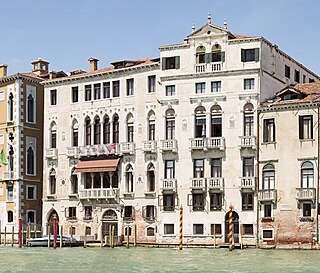
The Palazzi Barbaro—also known as Palazzo Barbaro, Ca' Barbaro, and Palazzo Barbaro-Curtis—are a pair of adjoining palaces, in the San Marco district of Venice, northern Italy. They were formerly one of the homes of the patrician Barbaro family. The Palazzi are located on the Grand Canal of Venice, next to the Palazzo Cavalli-Franchetti and not far from the Ponte dell'Accademia. The buildings are also known as the Palazzo Barbaro-Curtis. It is one of the least altered of the Gothic palaces of Venice.

The Palazzo Barbarigo Minotto is a 15th-century palace on the Grand Canal in Venice, northern Italy, next to the much larger Palazzo Corner. Built in the Venetian Gothic style, it was originally two palaces, Palazzo Barbarigo and Palazzo Minotto, later joined together. The Barbarigo palace was owned by the Barbarigo family for several centuries and was the birthplace of Gregorio Barbarigo, who once refused the Papal Crown. It was later owned by the Minotto and Martinengo families.

The Museo di Palazzo Mocenigo is a palazzo near the Church of San Stae, south of the Grand Canal in the sestiere of Santa Croce in Venice, Italy. It is now a museum of fabrics and costumes, run by the Fondazione Musei Civici di Venezia.
Palazzo Mocenigo may be one of the following palazzos in Venice, Italy, named after the Mocenigo family, seven of whom were Doges of Venice:

The Palazzo Mocenigo detto "il Nero" is a palazzo on the Grand Canal in Venice, Italy. Other Palazzi Mocenigo on each side include the Palazzo Mocenigo Casa Nuova and the Palazzo Mocenigo Casa Vecchia. The palazzo is located between the Rialto Bridge and St Mark's Square. It was occupied by the English poet Lord Byron (1788–1824) when he lived in Venice.

The Palazzi Mocenigo consist of the following complex of palazzos on the Grand Canal in Venice, Italy:

The Palazzo Mocenigo Casa Nuova is a palazzo on the Grand Canal in the sestiere of San Marco, Venice, Italy. The palazzo is located between the Rialto Bridge and St Mark's Square. The original Palazzo Mocenigo consisted four different buildings built for the Mocenigo family, seven of whom were Doges of Venice. Other Palazzi Mocenigo include the Palazzo Mocenigo Casa Vecchia and the Palazzo Mocenigo, forming a building complex designed for entertainment.

Francesco Contin was a Swiss-Italian sculptor and architect.

The Palazzo Giustinian Persico is an early-Renaissance-style palace located at the corner with the Rio di San Tomà, near Palazzo Tiepolo and across the canal from Palazzi Mocenigo on the Grand Canal, in the Sestiere of San Polo, Venice, Italy.
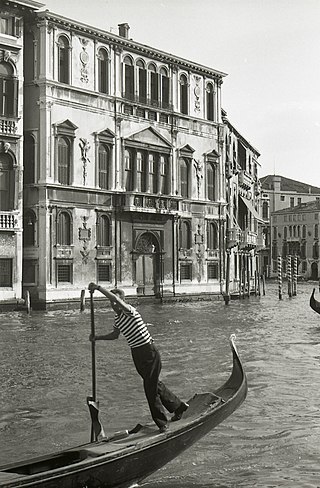
The Palazzo Contarini delle Figure is a Renaissance-style palace located between the Palazzo Mocenigo Ca' Vecchia and Palazzo Erizzo Nani Mocenigo, across the Grand Canal from the Palazzo Civran Grimani in the sestiere di San Marco in the city of Venice, Italy.
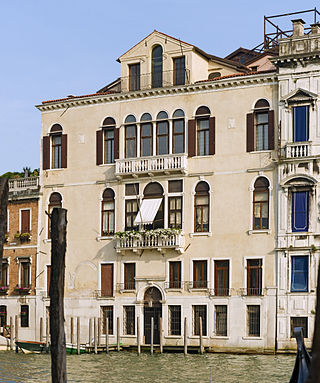
The Palazzo Corner Gheltof is Gothic-style palace located on the Grand Canal, in the Sestieri of San Marco, adjacent to the Palazzi Mocenigo, in Venice, Italy.

The Palazzo Trevisan Pisani is a Renaissance-style palace situated in the Campo Sant'Angelo in the sestieri of San Marco in Venice, Italy.

Palazzo Arese was a 16th century baroque palace and seat of a branch of the House of Arese in Milan, Italy. It was located adjacent to Casa Fontana Silvestri near the Porta Orientale. The palazzo was demolished in 1943 following damage sustained during the bombing of Milan in World War II.
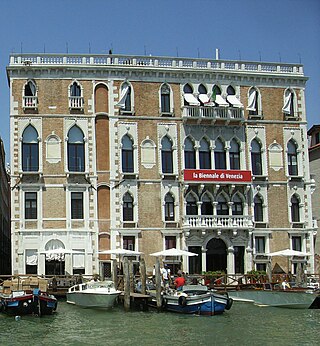
The Ca' Giustinian, sometimes called the Palazzo Giustinian, is a palace on the Grand Canal in the San Marco sestiere of Venice, Italy. It is today the seat of the Venice Biennale. Built in 1471, it was among the last Gothic palazzi built in Venice. It was partially modernized in the 17th century.
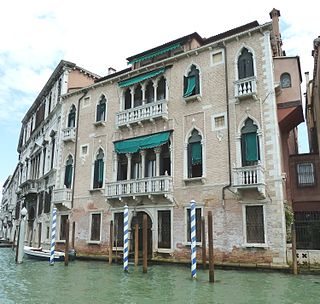
Palazzo Erizzo Nani Mocenigo is a palace in Venice located in the San Marco district and overlooking the Grand Canal between Palazzo Da Lezze and Palazzo Contarini delle Figure.

Palazzo Mocenigo Gambara is a palace in Venice, located in the Dorsoduro district and overlooking the Grand Canal, between the Contarini Palazzi degli Scrigni and Corfù and Palazzo Querini alla Carità, not far from the Gallerie dell'Accademia and in front of Palazzo Giustinian Lolin.
![]() Media related to Palazzo Mocenigo Casa Vecchia (Venice) at Wikimedia Commons 45°26′05″N12°19′46″E / 45.4346°N 12.3294°E
Media related to Palazzo Mocenigo Casa Vecchia (Venice) at Wikimedia Commons 45°26′05″N12°19′46″E / 45.4346°N 12.3294°E